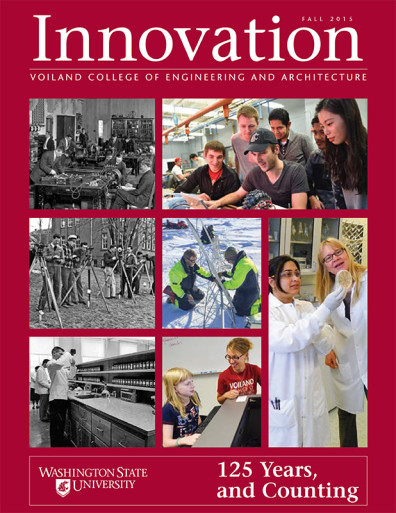Aerospace partnerships mean results
Alyssa Patrick, WSU Economic Development
 Mixing stainless steel with titanium is an idea that gives Amit Bandyopadhyay equally a headache and an adrenaline rush. In 20 years of research on additive manufacturing—or 3-D printing—Bandyopadhyay has experimented in printing bone material, moon rock, and plastics, but never two different metals at once.
Mixing stainless steel with titanium is an idea that gives Amit Bandyopadhyay equally a headache and an adrenaline rush. In 20 years of research on additive manufacturing—or 3-D printing—Bandyopadhyay has experimented in printing bone material, moon rock, and plastics, but never two different metals at once.
The challenge came to Bandyopadhyay, a researcher at Washington State University, from Aerojet Rocketdyne, a Seattle aerospace company looking for new, more efficient, and cost- effective ways to manufacture parts for satellites. The cross-state connection was made thanks to the Joint Center for Aerospace Technology Innovation (JCATI), an initiative launched by Washington’s Office of Aerospace to continue spurring growth of one of the state’s most vital economic sectors.
JCATI’s mission is to facilitate university–industry partnerships that advance research in new technologies and workforce development in the sector.
In the case of Aerojet Rocketdyne, the company was looking to simplify the manufacturing process of satellite parts that were made of different metals. While engineers at the company were using 3-D printing to fabricate sections of the part, they then had to weld the separate sections together. Existing specialty 3-D manufacturing companies are not doing any multi-material metal manufacturing, and would likely say it is impossible, making it a perfect opportunity for a university lab.
“In a lab, we can help a company find out if something is doable, or if a concept is worth pursuing,” Bandyopadhyay said. Presenting these kinds of applicable challenges to his graduate students also makes working with industry a priority for Bandyopadhyay.
“Students are the number one product of a university,” Bandyopadhyay said. “If we supplement their education with real-world opportunities that have three companies chasing after them at once, we know we have really done our job.”
Aerojet’s relationship with WSU continues today because both sides have taken the time to understand each other’s motivations and needs. This has included visits back and forth across the state—Bandyopadhyay sitting down with the Aerojet professionals in their offices, and Aerojet professionals touring the labs and visiting with WSU students.
“The benefit of JCATI is more than the money,” Bandyopadhyay said. “The funding is helpful to get the parties to the table, but the more important thing is facilitating relationships that otherwise might not happen.”
Roger Myers, executive director of Aerojet Rocketdyne and chair of the JCATI board, also listed interacting with students as one of the primary reasons industry should be working with universities. Though he has been in industry for decades now, Myers maintains relationships with universities across the country.
“Understanding how you transition from research to development is an important part of university–industry relationships,” he said. “Faculty at WSU have a better understanding of industry needs than other universities I have worked with. WSU is very innovative in its relationships and ability to be agile.”
After two years of working together on JCATI-supported projects, Aerojet gained a deeper understanding of the possibilities of additive manufacturing, and identified new techniques for manufacturing satellites. Bandyopadhyay and his graduate students were able to publish a paper on their findings and open a new avenue of possibilities for 3-D printing.
